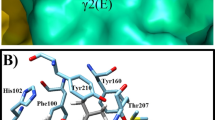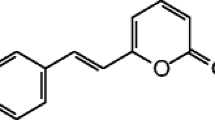Abstract
2-[(2,6-dichlorobenzylidene)amino]-5,6-dihydro-4H-cyclopenta[b]thiophene-3-carbonitrile), 5TIO1, is a new 2-aminothiophene derivative with a promising pharmacological activity. The aim of this work was to evaluate the potential anxiolytic effect of 5TIO1 in animal models. In the elevated plus-maze test, 5TIO1 (0.1, 1.0 and 10.0 mg/kg, i.p) increased the time of permanence and the number of entries in the open arms. In the light/dark box test, 5TIO1 at dose of 0.1 mg/kg (i.p) also showed anxiolytic-like effect indicated by an increase in the time spent in the light box, similar to diazepam 2.0 mg/kg (i.p). 5TIO1 groups did not change locomotor and coordination activities in open field and rotarod tests, respectively, when compared to vehicle. Dose dependent process was not observed and the anxiolytic effects demonstrated were not completely reversed by flumazenil 25 mg/kg (i.p). Our results suggest that 5TIO1 can bind with other receptors, besides the benzodiazepine site of the GABA receptor in mouse brain.

Similar content being viewed by others
References
Gross C, Hen R (2004) The developmental origins of anxiety. Nat Rev Neurosci 5:545–552. doi:10.1038/nrn1429
Wu L-J, Kim SS, Zhuo M (2008) Molecular targets of anxiety: from membrane to nucleus. Neurochem Res 33:1925–1932. doi:10.1007/s11064-008-9679-8
Kessler RC, Aguilar-Gaxiola S, Alonso J, Chatterji S, Lee S, Ormel J, Üstün TB, Wang PS (2009) The global burden of mental disorders: an update from the WHO World Mental Health (WMH) Surveys. Epidemiol Psichiatr Soc 18:23–33. doi:10.1017/S1121189X00001421
Fraser LM, Brown RE, Hussin A, Fontana M, Whittaker A, O’Leary TP, Lerdele L, Holmes A, Ramos A (2010) Measuring anxiety- and locomotion-related behaviours in mice: a new way of using old tests. Psychopharmacology 211:99–112. doi:10.1007/s00213-010-1873-0
Cryan JF, Holmes A (2005) The ascent of mouse: advances in modeling human depression and anxiety. Nat Rev Drug Discov 4:775–790. doi:10.1038/nrd1825
Crawley JN (2008) Behavioral phenotyping strategies for mutant mice. Neuron 27:809–818. doi:10.1016/j.neuron.2008.03.001
Taylor S, Abramowitz JS, Mackay D (2012) Non-adherence and non-response in the treatment of anxiety disorders. J Anxiety Disord 26:583–589. doi:10.1016/j.janxdis.2012.02.010
Rudolph U, Knoflach F (2011) Beyond classical benzodiazepines: novel therapeutic potential of GABAA receptor subtypes. Nat Rev Drug Discov 10:685–697. doi:10.1038/nrd3502
Vekovischeva O, Uusi-Oukari M, Korpi ER (2003) Tolerance to diazepam-induced motor impairment: a study with GAGAA receptor α6 subunit knockout mice. Neurochem Res 28:757–764. doi:10.1023/A:1022870002722
Goes TC, Antunes FD, Texeira-Silva F (2009) Trait and state anxiety in animal models: is there correlation? Neurosci Lett 450:266–269. doi:10.1016/j.neulet.2008.11.037
Amr AE-GE, Sherif MH, Assy MG, Al-Omar MA, Ragab I (2010) Antiarrythmic, serotonin antagonist and antianxiety activities of novel substituted thiophene derivatives synthesized from 2-amino-4,5,6,7-tetrahydro-N-phenylbenzol[b]thiophene-3-carboxamide. Eur J Med Chem 45:5935–5942. doi:10.1016/j.ejmech.2010.09.059
Mendonça-Junior FJB, Lima-Neto RG, Oliveira TG, Lima MCA, Pitta IR, Galdino SL, Cruz RMD, Araújo RSA, Neves RP (2011) Synthesis and evaluation of the antifungal activity of 2-(substituted-amino)-4,5-dialkyl-thiophene-3-carbonitrile derivatives. Lat Am J Pharm 30:1492–1499
Lister RG (1987) The use of a plus maze to measure anxiety in the mouse. Psychopharmacology 92:180–185. doi:10.1007/BF00177912
Crawley JN (1981) Neuropharmacologic specificity of a simple model for the behavioural actions of benzodiazepines. Pharmacol Biochem Behav 15:695–699. doi:10.1016/0091-3057(81)90007-1
Silva APS, Cerqueira GS, Nunes LCC, Freitas RM (2012) Effects of an aqueous extract of Orbignya phalerata Mart on locomotor activity and motor coordination in mice and as antioxidant in vitro. Pharmazie. 67:260–263. doi:10.1691/ph.2012.1105
Carlini EA, Burgos V (1979) Screening farmacológico de ansiolíticos: metodologia laboratorial e comparação entre o diazepam e o clorobenzapam. Rev Assoc Bras Psiquiatr 1:25–31
Sidor MM, Rilett K, Foster JA (2010) Validation of an automated system measuring anxiety-related behaviours in the elevated plus maze. J Neurosci Methods 188:7–13. doi:10.1016/j.jneumeth.2010.01.021
Alcalay RN, Giladi E, Pick CG, Gozes I (2004) Intranasal administration of NAP, a neuroprotective peptide, decreases anxiety-like behavior in aging mice in the elevated plus maze. Neurosci Lett 361:128–131. doi:10.1016/j.neulet.2003.12.005
Chacur C, Raymond R, Hipólide DC, Giugliano EB, Leite JR, Nobrega JN (1999) Immediate increase in benzodiazepine binding in rat brain after a single brief experience in the plus maze: a paradoxical effect. Neurosci Lett 269:29–32. doi:10.1016/S0304-3940(99)00425-5
Dhingra D, Chhillar R, Gupta A (2012) Antianxiety-like activity of gallic acid in ustressed and stressed mice: possible involvement of nitriergic system. Neurochem Res 37:487–494. doi:10.1007/s11064-011-0635-7
Bourin M, Hascoët M (2003) The mouse light/dark box test. Eur J Pharmacol 463:55–65. doi:10.1016/S0014-2999(03)01274-3
Huang T-Y, Lin C-H (2010) A comparison between chronic exercise training and desipramine as treatments for the depression-like behavior of early-life maternal deprivation rats. Neurosci Lett 480:201–205. doi:10.1016/j.neulet.2010.06.037
Mohler H, Malherbe P, Draguhn A, Richards JG (1990) GABAA-receptors: structural requirement and sites of gene expression in mammalian brain. Neurochem Res 15:199–207. doi:10.1007/BF00972210
Almeida AAC, Costa JP, Carvalho RBF, Sousa DP, Freitas RM (2012) Evaluation of acute toxicity of a natural compound (+)-limonene epoxide and its anxiolytic-like action. Brain Res 1448:56–62. doi:10.1016/j.brainres.2012.01.070
Nutt DJ, Malizia AL (2001) New insights into the role of the GABAA-benzodiazepine receptor in psychiatric disorder. Br J Psychiatry 179:390–396. doi:10.1192/bjp.179.5.390
Wierońska JM, Śmiałowska M, Brański P, Gasparini F, Kłodzińska A, Szewczyk B, Pałucha A, Chojnacka-Wójcik E, Pilic A (2004) In the amygdala anxiolytic action of mGlu5 receptors antagonist MPEP involves neuropeptide Y but not GABAA signaling. Neuropsychopharmacology 29:514–521. doi:10.1038/sj.npp.1300322
Acknowledgments
We would like to thank the National Council of Technological and Scientific Development (CNPq/Brazil), Coordination for the Improvement of Higher Level Personnel (CAPES), the Research Supporting Foundation of State of Piaui (FAPEPI/Brazil) and the Development Program of the Research and Post-graduation of the State University of Paraiba (PROPESQ-UEPB) for financial support, and Dr. Paulo Michel Pinheiro Ferreira (UFPI, Department of Biological Sciences, Picos, Piauí) for English edition.
Author information
Authors and Affiliations
Corresponding author
Rights and permissions
About this article
Cite this article
Fortes, A.C., Almeida, A.A.C., Mendonça-Júnior, F.J.B. et al. Anxiolytic Properties of New Chemical Entity, 5TIO1. Neurochem Res 38, 726–731 (2013). https://doi.org/10.1007/s11064-013-0970-y
Received:
Revised:
Accepted:
Published:
Issue Date:
DOI: https://doi.org/10.1007/s11064-013-0970-y




